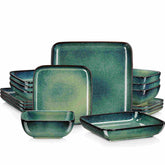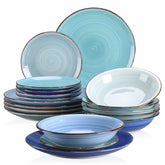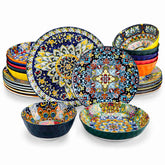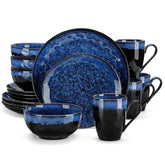Tailor Your Culinary Journey: How to Choose the Perfect Dinnerware for Every Cuisine
Dining is more than just eating—it’s about the whole experience. Every little detail, from the sizzling skillet to the sparkling wine glass, is important. Dinnerware is an often-neglected aspect that can make a big difference in your dining experience. Selecting the right plate, bowl, or platter is important for both function and storytelling. It sets the stage for the meal, affects the taste of the food, and represents the background of the cuisine.
The right dinnerware can make any meal, whether it is sushi, Italian, or tapas, look more attractive. We’ll look at how you can choose dinnerware that fits different world cuisines, making your meals at home more enjoyable and unique.
How Dinnerware Affects the Psychology of Presentation
Visual Appeal
It has been found that we use our eyes to decide what to eat before we taste it. A dish that is nicely arranged on the right plate tastes even better. For instance, white plates make desserts seem sweeter, while darker plates make savory foods appear richer. The way food is presented on a plate can either highlight its beauty or make it look dull. The right dinnerware highlights the beauty of the food being served.
Cultural Context
Dinnerware reflects the traditions of different cultures. A porcelain rice bowl fits perfectly in an Asian setting, while a tapas dish made from earthenware reflects Spanish culture. Using dinnerware that matches the cuisine helps preserve its cultural traditions. These small cultural hints make guests feel like they are traveling to different places without leaving the dining table.
Improving the Experience
Dinnerware is important because it affects the way we enjoy our meals. How heavy a bowl is, how smooth the rim is, or how big a pasta plate is can affect how much food we think we are eating and how we use our utensils. Dinnerware influences the way food is consumed, passed around, or enjoyed. All in all, the right dinnerware makes your meal more enjoyable and comfortable.
Matching Dinnerware with Different World Cuisines
Asian Cuisine: Simple and Practical Design
Balance, symmetry, and mindfulness are important aspects of Asian cuisine. The dinnerware used for Asian dishes is simple yet very functional. Consider using small rice bowls, lacquered trays, bamboo steamers, dipping sauce dishes, and porcelain soup spoons. For example, Japanese aesthetics appreciate the idea of wabi-sabi, which means seeing beauty in things that are not perfect. This style looks best with matte surfaces, unusual shapes, and soft colors. When you are serving Chinese or Thai food, choose porcelain with light floral designs or celadon glazes. Black or stone-grey dinnerware looks great with the colorful dishes of sushi, stir-fries, and noodles.
Italian & Mediterranean Cuisine: Simple Charm and Plenty of Food
Mediterranean meals are hearty, meant for sharing, and have a lot of character. The dinnerware should be sturdy, simple, and a bit bigger to fit the generous portions served. Choose wide pasta bowls, terracotta platters, and olive-wood serving boards. Earthy colors, bright oranges, deep blue, and hand-painted ceramics that remind us of coastal villages and open-air markets are often used in color palettes. The way a piece feels can also be important—matte or slightly textured surfaces can make a room feel cozier. Since this cuisine is all about abundance, the dinnerware should reflect that.
Modern American & European Fusion: Simple Lines & Flexible Neutral Colors
When serving dishes that mix flavors from around the world with modern cooking, the dinnerware should be simple and unobtrusive. Because creativity and a neat presentation are important, simple lines, basic shapes, and one-color palettes are preferred. Choose square plates with a simple design, black or white stoneware, and dishes with geometric shapes. It’s important that the pieces can be used for both a seared tuna tartare and a vegan risotto. The dinnerware should be flexible, allowing the food to be the main focus.
Mexican & Latin American Cuisine: Bright Colors & Strong Textures
Since Latin American dishes are colorful and full of flavor, your dinnerware should also be vibrant. You can find colorful glazes, hand-painted designs, and strong materials in handmade clay bowls and Talavera pottery. The main colors in the design are red, orange, turquoise, and sunflower yellow. The colors in these dishes are similar to the spicy and lively flavors found in tacos, arepas, and empanadas. Using heavy ceramics or glazed stoneware helps keep the food warm and gives the meal a genuine feel.
Matching Dinnerware Elements
Besides the main dishes, accessories help complete the look of the dining table. Think of:
- Asian meals are served with chopsticks, small soy dishes, and bamboo mats.
- Bread plates with a crust and olive oil bowls for Mediterranean meals.
- For modern dishes, use ramekins, metal skewers, or glass coupes.
- Mini cazuelas, salsa bowls, and margarita glasses are perfect for serving Latin dishes.
The napkins, utensils, and drinkware can also add to the overall look of the table. Choose textures such as linen, ceramic glaze, or brushed metal that go well with your dinnerware.
Creating a Dinnerware Collection That Works for Different Cuisines
You can show your culinary skills with dinnerware without filling your cabinets with too many plates. This involves choosing carefully and mixing main pieces with themed decorations.
Include Accent Items
Use a good quality white or light grey porcelain base set and add accent pieces that match your favorite types of food. A few Japanese rice bowls, a couple of terracotta tapas plates, or a lively salsa bowl can quickly change the atmosphere at the table. These little touches can make a big difference in how your meal looks.
Try Mix-and-Match
It’s no longer necessary for all the plates to be the same. Combining various textures, shapes, and patterns helps you express your creativity. A plain ceramic charger with a modern plate on top? A colorful salad plate and a plain soup bowl? There are countless possibilities. This also make it simpler to serve different types of food without having to buy a full set for every cuisine.
Focus on Quality Over Quantity
Choose to buy fewer, better-made items that will last for a long time. Choose dishes made from porcelain, bone china, or high-fired stoneware, as they are less likely to chip or change color. Good dinnerware lasts longer and also makes meals more enjoyable because it looks and feels better. If you enjoy the dishes you have, you’ll be more eager to serve and enjoy your meals.
Elevate Your Dinnerware, Elevate Your Life
Dinnerware is not only for serving food; it also adds to the experience by enhancing the taste and appearance of every dish. When you include dishes from different cultures in your collection, you can turn simple meals into exciting experiences. A Japanese tea bowl may be serene, while a painted Spanish platter is full of charm, but every piece is important in its own way.When you know how different cultures affect dinnerware and how it affects the taste, smell, and appearance of food, you go beyond being a cook. You start to shape the experiences you have. Enjoy your meals thoughtfully, enjoyably, and let your food express both flavor and tradition.













